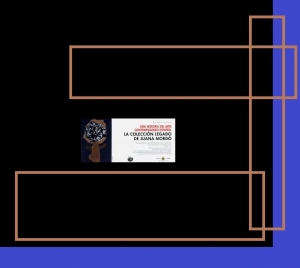A history of Spanish Contemporary Art. The Juana Mordó legacy collection (2010)
Text: Extracted from the exhibition programme (2010)
The Juana Mordó legacy collection Exhibition organised by the Valladolid City Council/Municipal Culture Foundation and the Círculo de Bellas Artes

JUANA MORDÓ
Juana Mordó (1899-1984) was a woman of the world who, in 1943, in the midst of the post-war period, stopped in Madrid. And it was in this city that she dedicated part of her last years to her gallery. On the 14th of March 1964 the main headquarters of the Juana Mordó gallery, situated in Calle Villanueva,7, in Madrid, was opened to the public with a collective exhibition. This was the place where 20 years earlier her teacher and friend Eugenio d’ Ors had held The Salons of the Eleven.
After this inaugural exhibition, Lucio Muñoz will have his first of six individual exhibitions that Juana has held for him. Born in Thessaloniki (Greece), of Jewish origin, with a Catalan surname, and after living in Paris and Berlin, Juana Mordó managed to open her gallery after having worked in Spain with editorial themes in La Rosa Vera, or as an editor for Radio Nacional. But it is her time as artistic director in the Biosca gallery from 1958 to 1963 that will bring her closer to the world of plastic artists.
When she says goodbye to Aurelio Biosca, he expresses his differences with Juana Mordó’s personality, although he acknowledges that she was “a great saleswoman”. Antonio López will highlight her generosity with him, as well as her “devilish character”. In 1953 she was the secretary of the commission for the 1st International Exhibition of Open Air Sculpture in the autumn of that year in the Retiro Park in Madrid, from which the work “Girl on a Chair” by Giacomo Manzú, now in the Reina Sofía Museum collection, originated. With a vast culture, with her correct Spanish – she spoke in French with her dogs, cats and money -, with her hat and her fur coats, at the age of retirement of 65 and until her death in 1984, this “little old lady” of art became the great lady of the avant-garde of the fifties and of the young creators that she promoted in her Madrid gallery.
In addition to her headquarters in Calle Villanueva, she opened other branches in the streets of Castelló and Princesa in good times, which she closed after four years. The collector and president of the Board of Trustees of the Reina Sofia National Museum, Pilar Citoler, remembers how in 1969 she obtained an important work for the first time: “my first serious painting that I bought is the oil by José Caballero “El andaluz perdido”, acquired in the Juana Mordó gallery in Madrid”. Other artists such as Amalia Avia declare her difficult character, her cheekiness, her intelligence and her hard work as her particularities. However, for Jaime Burgillos” was a fascinating woman, who I admired very much, above all because she liked to sell art and had an incredible eye for the client”. That knowledge of selling is what Bonifacio highlights from Juana Mordó: “she was the best gallery owner I have ever known”.
In 1974, on her tenth anniversary, she decided to present drawings by Kandinsky without much success. He only managed to sell one. Neither was the exhibition by Fernando Botero, between 5 and 24 February 1968, which he was unable to award any piece. He helped current gallery owners such as Kagda Belloti, artists such as Carmen Laffón, who showed in Biosca and in his Gallery in 67, and of course Benjamín Palencia and Manuel Viola, who always placed undecided customers.
He displayed works from the El Paso group: almost all of them passed through his walls, with sackcloths by Millares, the imaginary portraits of Saura, the grilles of Rivera, the woods of Lucio Muñoz, or the iron spirals of Martín Chirino, together with Pablo Serrano, Juana Francés, Suárez, Feito and Canogar. He showed the abstract works of the great artists such as Enrique Gran, Jaime Burguillos, Salvador Victoria, Farreras, the aerial writings of Mompó, the geometries of Sempere and Palazuelo, or the artists from Cuenca among whom Zobel, Torner, Gerardo Rueda, Bonifacio and Lorenzo stand out. In front of them, the Madrid and Seville realists, with Julio López Hernández, Carmen Laffón and Amalia Avia among others. He was very friendly with Antonio López, but he only presented him in his gallery at the inaugural group show in 1964.
In the seventies, he showed works by Equipo Crónica, Arroyo, Juan Martínez or Darío Villalba, until the eighties, when he opened an exhibition of young Spanish artists with great public and critical success, among which Fernando Mignoni, Alfonso Fraile, Eduardo Chillida or Gordillo stood out. In addition, he exhibited in his last stage Pérez Villalta, Broto, Campano, Espaliú, Santiago Serrano, Fontcuberta, Corbeira, Miura and Susana Solano. When he died, his collaborator Helga de Alvear, continued with the gallery until 1994.
He did not forget to show us European artists such as César, his friend the Swiss artist Jean Lecoutre, Hartung, Erté, David Hockney or Nan June Paik. Also the Hispanic Americans were represented in his room with Botero, Rómulo Macció, or Miguel Condé, and he visited the great international art events, such as the fairs of Cologne, Basel, the FIAC in Paris, or Arco in Madrid, to make Spanish artists known outside our borders. Generous, flirtatious and mysterious, her artistic legacy was donated to the Círculo de Bellas Artes in Madrid, with more than 250 works, including paintings, sculptures and drawings, together with more than 3,000 books. All this, as a summary of her 20 years of gallery activity, and her more than 200 artists exhibited in her Madrid gallery.
